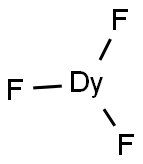PRODUCT Properties
| Melting point: | 1412 °C (lit.) |
| Boiling point: | 2567 °C (lit.) |
| Density | 8.559 g/mL at 25 °C (lit.) |
| storage temp. | 15-25°C |
| solubility | soluble in dilute acid solutions |
| form | powder |
| Specific Gravity | 8.54 |
| color | Silver-gray |
| PH | 0.5 (20°C in H2O) |
| Resistivity | 89 μΩ-cm, 20°C |
| Water Solubility | reacts slowly with H2O; soluble dilute acids [HAW93] |
| Sensitive | Air & Moisture Sensitive |
| Merck | 13,3515 |
| Exposure limits | ACGIH: TWA 2 ppm; STEL 4 ppm OSHA: TWA 2 ppm(5 mg/m3) NIOSH: IDLH 25 ppm; TWA 2 ppm(5 mg/m3); STEL 4 ppm(10 mg/m3) |
| CAS DataBase Reference | 7429-91-6(CAS DataBase Reference) |
| EPA Substance Registry System | Dysprosium (7429-91-6) |
Description and Uses
There are not many uses for dysprosium. Scientists continue to experiment with it as apossible alloy metal (it has a high melting point) to be mixed with steel to make control rodsthat absorb neutrons in nuclear reactors. There are only a few commercial uses for dysprosium,such as a laser material and as a fluorescence activator for the phosphors used to produce thecolors in the older TV and computer cathode ray tubes (CRTs). When combined with steelor nickel as an alloy, it makes strong magnets.
Safety
| Symbol(GHS) |   GHS02,GHS07 |
| Signal word | Danger |
| Hazard statements | H228-H251-H315-H319-H413 |
| Precautionary statements | P210-P235-P240-P273-P302+P352-P305+P351+P338 |
| Hazard Codes | F,C |
| Risk Statements | 11-34 |
| Safety Statements | 22-24/25-36/37/39-33-16-45-27-26-23 |
| RIDADR | UN 3089 4.1/PG 2 |
| WGK Germany | 3 |
| F | 10 |
| TSCA | Yes |
| HazardClass | 8 |
| PackingGroup | III |
| HS Code | 28053012 |




